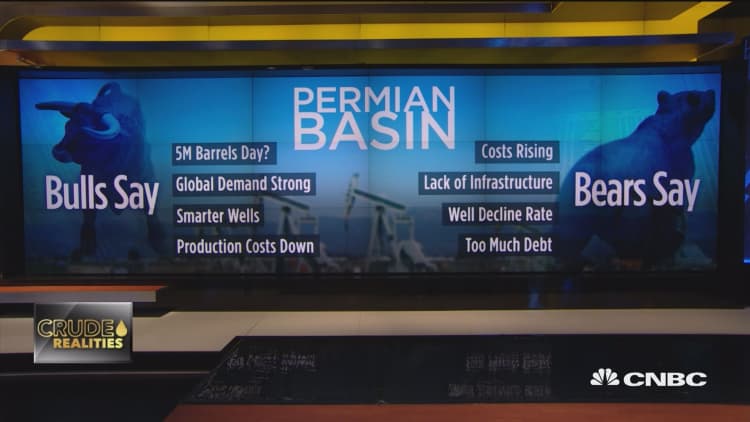
Oil prices slumped to more than two-week lows on Thursday as global stock markets fell, with investor sentiment made more bearish by a bigger-than-expected U.S. crude inventories build.
Crude inventories climbed by 6 million barrels in the week to Oct. 5, the U.S. Energy Information Administration reported, compared with analyst expectations for an increase of 2.6 million barrels.
Brent crude fell $2.83, or 3.4 percent, to $80.26 a barrel by 2:30 p.m. ET, its lowest level since Sept. 24. Brent lost 2.2 percent on Wednesday. On Oct. 3, it hit a four-year high of $86.74.
U.S. light crude ended Thursday's session down $2.20, or 3 percent, to $70.97. The contract lost 2.4 percent in the previous session.

U.S. crude inventories rose 6 million barrels last week, the Energy Information Administration said, more than double analysts' expectations of a 2.6 million-barrels increase.
The stockpiles rose for the third consecutive week as refineries continued to reduce production for seasonal maintenance. Refinery crude runs fell by 352,000 barrels per day as utilization rates dropped 1.6 percentage points, the EIA data showed.
"It was a mostly bearish report. The large increase in overall crude oil inventories and a decent-sized increase at the Cushing, Oklahoma, delivery hub is a negative for prices, as it eases some of the supply crunch worries that have crept into the market," said John Kilduff, a partner at Again Capital Management in New York.
U.S. oil output is expected to rise 1.39 million bpd to a record 10.74 million bpd, the EIA said in its monthly forecast on Wednesday.
Goldman Sachs says U.S. shale oil production can continue to increase by 1 million bpd every year until 2021, according to a new report by the investment bank.
Falling U.S. equity markets and a global risk-off environment also weighed on crude futures. On Wednesday, U.S. stock markets tumbled, with the S&P 500 and the Dow Industrials indexes posting their worst day in eight months, as solid economic data reinforced expectations of multiple interest rate hikes over the next year.

"The demand side of the oil equation is always much more difficult to discern than the more transparent supply side and as equities slide amidst rate increases, the oil market could begin to discount a worst case scenario with regard to oil demand expectations," Jim Ritterbusch, president of Ritterbusch and Associates, said in a note.
OPEC cut its forecast of global demand growth for oil next year for a third straight month on Thursday, citing headwinds facing the broader economy from trade disputes and volatile emerging markets.
In the U.S. Gulf of Mexico, producers were checking production platforms and beginning to return crews to more than 90 offshore facilities evacuated this week as Hurricane Michael moved through the Gulf.
Production shut-ins that temporarily halted 42 percent of Gulf oil output was restarting in some areas.
Michael crashed ashore Florida on Wednesday as the third most powerful hurricane ever to strike the U.S. mainland. It has since weakened to a tropical storm.

